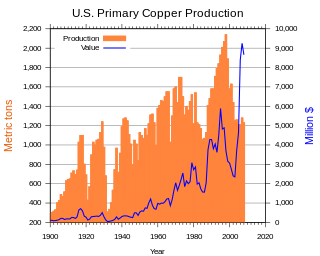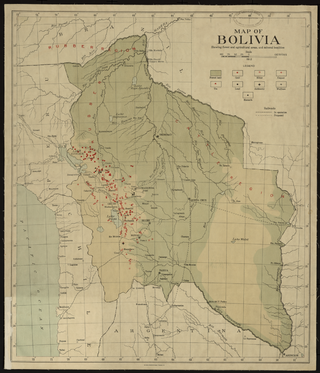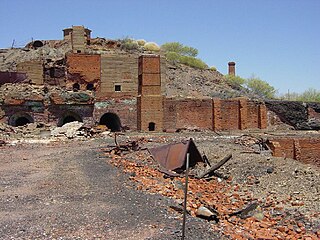Related Research Articles

Mining is the extraction of valuable geological materials and minerals from the surface of the Earth. Mining is required to obtain most materials that cannot be grown through agricultural processes, or feasibly created artificially in a laboratory or factory. Ores recovered by mining include metals, coal, oil shale, gemstones, limestone, chalk, dimension stone, rock salt, potash, gravel, and clay. The ore must be a rock or mineral that contains valuable constituent, can be extracted or mined and sold for profit. Mining in a wider sense includes extraction of any non-renewable resource such as petroleum, natural gas, or even water.

Chuquicamata is the largest open pit copper mine in terms of excavated volume in the world. It is located in the north of Chile, just outside Calama, at 2,850 m (9,350 ft) above sea level. It is 215 km (134 mi) northeast of Antofagasta and 1,240 km (770 mi) north of the capital, Santiago. Flotation and smelting facilities were installed in 1952, and expansion of the refining facilities in 1968 made 500,000 tons annual copper production possible in the late 1970s. Previously part of Anaconda Copper, the mine is now owned and operated by Codelco, a Chilean state enterprise, since the Chilean nationalization of copper in the late 1960s and early 1970s. Its depth of 850 metres (2,790 ft) makes it the second deepest open-pit mine in the world, after Bingham Canyon Mine in Utah, United States.

Copper extraction refers to the methods used to obtain copper from its ores. The conversion of copper ores consists of a series of physical, chemical, and electrochemical processes. Methods have evolved and vary with country depending on the ore source, local environmental regulations, and other factors.

The National Copper Corporation of Chile, abbreviated as Codelco, is a Chilean state-owned copper mining company. It was formed in 1976 from foreign-owned copper companies that were nationalised in 1971.

The Bingham Canyon Mine, more commonly known as Kennecott Copper Mine among locals, is an open-pit mining operation extracting a large porphyry copper deposit southwest of Salt Lake City, Utah, in the Oquirrh Mountains. The mine is the largest human-made excavation, and deepest open-pit mine in the world, which is considered to have produced more copper than any other mine in history – more than 19,000,000 short tons. The mine is owned by Rio Tinto Group, a British-Australian multinational corporation. The copper operations at Bingham Canyon Mine are managed through Kennecott Utah Copper Corporation which operates the mine, a concentrator plant, a smelter, and a refinery. The mine has been in production since 1906, and has resulted in the creation of a pit over 0.75 miles (1,210 m) deep, 2.5 miles (4 km) wide, and covering 1,900 acres. It was designated a National Historic Landmark in 1966 under the name Bingham Canyon Open Pit Copper Mine. The mine experienced a massive landslide in April 2013 and a smaller slide in September 2013.

Silver mining is the extraction of silver by mining. Silver is a precious metal and holds high economic value. Because silver is often found in intimate combination with other metals, its extraction requires the use of complex technologies. In 2008, approximately 25,900 metric tons of silver were consumed worldwide, most of which came from mining. Silver mining has a variety of effects on the environment, humans, and animals.

Mining in Iran is still under development, yet the country is one of the most important mineral producers in the world, ranked among 15 major mineral-rich countries, holding some 68 types of minerals, 37 billion tonnes of proven reserves and more than 57 billion tonnes of potential reserves worth $770 billion in 2014. Mineral production contributes only 0.6 percent to the country's GDP. Add other mining-related industries and this figure increases to just four percent (2005). Many factors have contributed to this, namely lack of suitable infrastructure, legal barriers, exploration difficulties, and government control.
Mount Isa Mines Limited ("MIM") operates the Mount Isa copper, lead, zinc and silver mines near Mount Isa, Queensland, Australia as part of the Glencore group of companies. For a brief period in 1980, MIM was Australia's largest company. It has pioneered several significant mining industry innovations, including the Isa Process copper refining technology, the Isasmelt smelting technology, and the IsaMill fine grinding technology, and it also commercialized the Jameson Cell column flotation technology.

In the United States, copper mining has been a major industry since the rise of the northern Michigan copper district in the 1840s. In 2017, the US produced 1.27 million metric tonnes of copper, worth $8 billion, making it the world's fourth largest copper producer, after Chile, China, and Peru. Copper was produced from 23 mines in the US. Top copper producing states in 2014 were Arizona, Utah, New Mexico, Nevada, and Montana. Minor production also came from Idaho and Missouri. As of 2014, the US had 45 million tonnes of known remaining reserves of copper, the fifth largest known copper reserves in the world, after Chile, Australia, Peru, and Mexico.
Serbia Zijin Bor Copper, formerly known as RTB Bor, is a copper mining and smelting complex located in Bor, Serbia.

Mining in Bolivia has been a dominant feature of the Bolivian economy as well as Bolivian politics since 1557. Colonial era silver mining in Bolivia, particularly in Potosí, played a critical role in the Spanish Empire and the global economy. Tin mining supplanted silver by the twentieth century and the central element of Bolivian mining, and wealthy tin barons played an important role in national politics until they were marginalized by the industry's nationalization into the Bolivian Mining Corporation that followed the 1952 revolution. Bolivian miners played a critical part to the country's organized labor movement from the 1940s to the 1980s.

Mopani Copper Mines PLC is a Zambian company that produces and sells copper and cobalt to the international market, being one of the biggest mines and exporters in the world.
Montana silver mining was a major industry in the 1800s following discovery of numerous silver deposits. Between 1883 and 1891 Montana was second every year to Colorado in silver production, except for 1887 when Montana was number one, producing approximately $15.5 million worth of silver. Major mining districts in Montana included Butte, which was home to many important mines such as the Lexington, Alice, and Moulton mines, and Philipsburg, which housed the Granite Mountain and Bimetallic mines. Other influential, but significantly smaller mines, operated at Helena and the Castle Mountains. The rapid raise and fall of these mines were due to largely geological and economic factors that created favorable conditions for a silver mining boom and subsequent bust. Montana continued to produce considerable silver through most of the 1900s, as a byproduct of copper production at Butte.

Adolphus William Copper Smelter is a heritage-listed former copper smelter and associated mining camp at Westwood and Oakey Creek in Rockhampton Region, Queensland, Australia. It was built in 1874. It was added to the Queensland Heritage Register on 13 May 2011.

OK Mine & Smelter is a heritage-listed mine at Kitoba Holding, Bellevue, Shire of Mareeba, Queensland, Australia. It was built from 1902 to 1942. It was added to the Queensland Heritage Register on 2 October 1996.
Einasleigh Copper Mine and Smelter is a heritage-listed mine at Daintree Road, Einasleigh, Shire of Etheridge, Queensland, Australia. It was built from 1867 to 1922. It is also known as Lynd Copper Mine and New Einasleigh Copper Mine. It was added to the Queensland Heritage Register on 11 December 2006.

Mount Elliott Mining Complex is a heritage-listed copper mine and smelter at Selwyn, Shire of Cloncurry, Queensland, Australia. It was designed by William Henry Corbould and built in 1908. It is also known as Mount Elliott Smelter and Selwyn. It was added to the Queensland Heritage Register on 16 September 2011.
The metallurgical production of the Republic of Azerbaijan is considered high due to the large deposits of alunite, polymetallic ores, deposits of iron ore, etc. The metallurgy industry of Azerbaijan encompasses both ferrous and non-ferrous branches.

The Industrial Revolution in Wales was the adoption and developments of new technologies in Wales in the 18th and 19th centuries as part of the Industrial Revolution, resulting in increases in the scale of industry in Wales.
References
- ↑ "Mineral deposits of Serbia". docstoc.com. 2012. Archived from the original on 13 February 2015. Retrieved 28 June 2013.
- 1 2 3 4 5 6 Ilić, Saša (November 6, 2019). "The Bor Mine in Serbia: labour and landscape throughout the 20th century". Europeana (CC By-SA). Translated by Tatjana Domazet. Archived from the original on 2019-11-06. Retrieved 2019-11-07.
